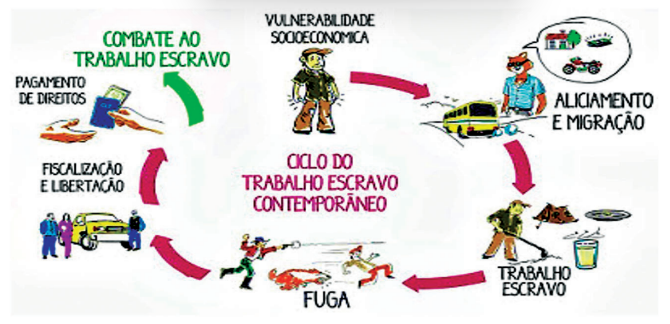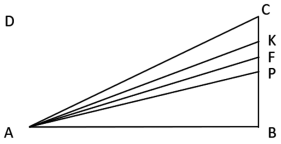Questões de Vestibular UEMA 2021 para Vestibular - 2º Dia
Foram encontradas 44 questões
Essa teoria do século XVIII que juntou racionalismo e empirismo é conhecida como
O que é cultura? Cultura tem vários significados, como cultura da terra ou cultura de uma pessoa letrada, “culta”. Em antropologia, cultura significa tudo o que o ser humano produz ao construir sua existência: as práticas, as teorias, as instituições, os valores materiais e espirituais. Se o contato com o mundo é intermediado pelo símbolo, a cultura é o conjunto de símbolos elaborados por um povo.
ARANHA, Maria Lúcia de Arruda e MARTINS, Maria Helena Pires. Filosofando: introdução à filosofia. São Paulo: Moderna, 2013, p. 37
Considerando a definição de cultura da perspectiva antropológica, não se pode naturalizá-la porque a cultura é
Vejamos exemplo de um silogismo.
• Todo brasileiro é sul-americano. • Todo nordestino é brasileiro. • Logo, todo nordestino é sul-americano.
https://www.todamateria.com.br/silogismo
Como é classificado esse tipo de silogismo?
O que significam as eleições? Muito mais do que mera rotatividade de governo ou alternância no poder. Simbolizam o essencial da democracia: que o poder não se identifica com os ocupantes do governo, não lhes pertence, mas é sempre um lugar vazio, que o cidadão, periodicamente, preenche com um representante, podendo revogar seu mandato se não cumprir o que lhe foi delegado para representar.
CHAUI, Marilena. Filosofia. São Paulo: Ática, 2007.
Podem-se relacionar as palavras da filósofa ao quadro político brasileiro, de forma crítica. Uma das ideologias no Brasil possibilita a dissimulação da prática política porque procura legitimar para o cidadão que o poder é

https://twitter.com/QuebrandoOTabu/status/1096740979715956738/photo/1
Analise as assertivas, considerando a leitura.
I) Trata-se de racismo estrutural, dado que, historicamente, um grupo étnico foi relegado à subalternidade, perpetuando a estrutura desigual da sociedade brasileira, que exclui indivíduos e grupos em função das suas características físicas. II) Revela-se em racismo científico, uma vez que a tese da eugenia procurou associar características físicas herdadas biologicamente com traços intelectuais e morais, defendendo existir seres humanos superiores e inferiores. III) Demonstra o racismo institucional, visto que há tratamento diferenciado para as pessoas conforme seu fenótipo por parte de agentes públicos e privados que trabalham em organizações, em empresas e em instituições. IV) Exprime o racismo criminal, na medida em que o critério racial se tornou elemento explicativo das diferenças de aptidões profissionais e das tendências criminosas, associando habilidades e tendências à ideia do determinismo genético.
As formas de racismo explicitadas na sequência em quadrinhos estão nomeadas e explicadas, sociologicamente, apenas, nas assertivas

http://trabalhoescravocontemporaneo.blogspot.com/2017/09/trabalho-escravo-contemporaneo.html
Avalie as assertivas abaixo.
I) A escravidão chamada de contemporânea é, apenas, uma forma de burlar a legislação trabalhista, não causando danos nem para o empregador nem para o empregado. II) A manutenção do trabalho forçado e das jornadas exaustivas é necessária para o cumprimento das metas de produção estabelecidas pelos compradores dos produtos. III) Os trabalhadores em situação análoga à escravidão são vítimas do desemprego e da falta de condições de vida em seus municípios, o que os faz aceitar ofertas de trabalho em outras regiões. IV) o trabalho escravo contemporâneo tem maior incidência no setor primário, em região de expansão agrícola, sobretudo nas atividades da pecuária, da produção de carvão e do cultivo de cana-de-açúcar.
As assertivas corretas sobre trabalho análogo à escravidão, retratado na imagem, são, apenas,
MACHADO, I. J. de R; AMORIM, H; BARROS, C. R. Sociologia Hoje: ensino médio. Volume único. 2. Ed. São Paulo: Ática, 2016. Adaptado.
A situação que confirma a continuidade, no século XXI, da característica diagnosticada pelo sociólogo é a seguinte:
TEXTO I
Alcoa 390 Park Avenue New York, NY 10022-4608 EUA Klaus Kleinfeld Presidente e CEO
Prezado colega,
Sua cópia pessoal do Guia de Conduta Comercial da Alcoa encontra-se anexa. Os Valores da Alcoa são a base sobre a qual esta empresa foi construída e continua a prosperar. É importante que cada um de nós entendamos e vivamos os Valores da Alcoa — eles orientam nossas interações com os clientes, fornecedores, colegas de trabalho, acionistas e as comunidades nas quais operamos. Somos uma empresa global com operações em diferentes ambientes culturais, políticos e econômicos. Em todas as nossas operações, os Valores da Alcoa e a nossa integridade continuam sendo nosso norte.
[...] Este Código
Este Código de Conduta Empresarial descreve a responsabilidade da Alcoa e de seus funcionários para com os integrantes da própria empresa, para com nossos parceiros mundiais e para com nossas comunidades. Ajuda-nos a compreender as responsabilidades que compartilhamos e nos alerta para questões jurídicas e éticas importantes que possam surgir. Este documento não pretende abranger todas as políticas, procedimentos e padrões da Alcoa. Talvez você não encontre aqui todas as respostas que esteja procurando. Mas você encontrará exemplos dos Valores básicos e ilustrativos do modo de atuar escolhido pela Alcoa e do comportamento esperado de cada funcionário na condução das atividades da empresa. (Código de Conduta)
https://www.alcoa.com/brasil/pt/pdf/PortBrazil-guide06.pdf. (Adaptado).
TEXTO II
O que é a Etiqueta Social Para entender o que é etiqueta social deve-se ter em mente que existem situações sociais que requerem comportamentos específicos. Basicamente, a etiqueta social é definida como um conjunto de regras de comportamento e boas maneiras a serem seguidas dentro da sociedade e suas respectivas situações. Essas regras são criadas a partir da prática, bom senso e das tradições que passam de geração para geração, consolidando-se como padrões de comportamento claros e bem respeitados.
[...] Dicas de etiqueta para as redes sociais e internet
Não poste fotos chocantes
Ninguém deve ser obrigado a ver fotos de pessoas mortas, animais maltratados ou pessoas mutiladas. Tome cuidado ao curtir fotos assim ou compartilhá-las para não incomodar seus amigos virtuais.
https://socilaescola.com.br/regras-de-etiqueta-social/ (Adaptado).
As grandes empresas estipulam seus códigos de conduta para seus funcionários, a exemplo do Código de Conduta da ALCOA. Por outro lado, a sociedade também estipula norma social coletiva, mesmo que não tenha previsão legal, a exemplo das regras de etiqueta, apresentadas no texto II.
As duas situações retratadas, nos textos I e II, apresentam em comum o fato de se constituírem, sociologicamente, como
Ao chegar ao aeroporto da capital, alugou um carro e planejou sair às 8h da manhã e dirigir a 90 km/h para ter algum tempo de sobra. O turista conseguiu manter os primeiros 90 km com a velocidade planejada. Próximo à cidade de Rosário – MA, encontrou um trecho da estrada em obras, o que o fez reduzir sua velocidade para 40 km/h por 40 km.

https://www.google.com.br (Adaptado)
Qual a menor velocidade, km/h, que o turista deve manter no restante da viagem para chegar a tempo de fazer o passeio?
Uma moradora com necessidade de resfriar 3000 g de água em um recipiente, inicialmente a uma temperatura de 30 °C, adiciona gelo a –20°C. Considere que todo gelo se funde e que o calor específico do recipiente pode ser desprezado.
Dados: calor específico da água = 1 cal/g °C; calor específico do gelo = 0,5 cal/g °C; calor latente de fusão do gelo = 80cal/g.
A quantidade de gelo, em g, para que a temperatura final seja igual a 0 °C é
https://novaescola.org.br/conteudo/1084/o-que-e-e-como-funciona-um-acelerador-de-particulas (Adaptado)
Cientistas, em um experimento, colocam uma partícula positiva de massa 2.10-17 kg carga elétrica 2 µC que se mantém em uma trajetória circular de raio 5 cm, graças ao campo magnético de 8,0.10-5 T, perpendicular à trajetória da partícula. A velocidade da partícula, em m/s, é igual a
A figura a seguir representa a emissão fotoelétrica em uma placa de césio com função trabalho de 2,14 eV, iluminada pela radiação violeta, com comprimento de onda igual a 400 nm. hƒ é a energia dos fótons; EC é a energia cinética máxima dos elétrons emitidos e W é a função trabalho do material de que é feito o alvo, ou seja, a energia mínima que um elétron deve adquirir para poder escapar do material.
 A figura está sem escala, uso de cores fantasia.
A figura está sem escala, uso de cores fantasia. Considerando a constante de Planck 4,2.10-15 eVs e a velocidade da luz no vácuo de 3,0.108 m/s, a energia cinética, em eV do elétron ejetado, é igual a
Ao final da identificação, constatou-se que 6% estavam com COVID-19; 3% estavam gripadas; 92% das pessoas não estavam com nenhuma das duas doenças.
Ao escolher um apoiador desse comício ao acaso e, sabendo que ele não está com COVID-19, qual a probabilidade de que esse apoiador esteja somente gripado?

A tangente do ângulo FÂP é

Considerando que cada bola de basquete tem raio igual a “r” cm e que tangenciam todos os lados internos das faces da embalagem cúbica, o valor, em cm³, do espaço vazio dentro da caixa, ou seja, o espaço não preenchido pelas bolas de basquete é
Segundo a lei da depreciação indicada, o caminhão valerá um oitavo do valor de aquisição com
Analise o esquema de uma célula animal, tendo indicadas diferentes organelas citoplasmáticas, sendo “A” responsáveis pela liberação de energia e pela respiração celular; “B”, as que realizam o empacotamento e a secreção das substâncias produzidas pela célula e “C”, organelas que atuam na organização do fuso mitótico, da produção de cílios e de flagelos.

LINHARES, Sérgio; GEWANDSZNAJDER, Fernando. Biologia. V. 3. São Paulo: Ática, 2014.
As organelas citoplasmáticas referentes aos esquemas A, B e C correspondem, respectivamente, a
LOPES, Sônia; ROSSO, Sérgio. BIO: volume único. 2. ed. São Paulo: Saraiva, 2013.
Correlacione as principais modificações foliares e suas respectivas características.

Estão corretas as seguintes correlações:
https://www.sbd.org.br/dermatologia/pele/doencas-e-problemas/herpes
Em relação ao herpes é correto afirmar que se trata de uma patologia de infecção
Em 08 de dezembro de 2020, foi publicado, no Rio Grande do Sul, um relatório de monitoramento de surto de gafanhotos, mostrando o raio de ação de 30 km em municípios atingidos, pontos de levantamento da infestação com a densidade de incidência, visando ao controle da praga, conforme indicado na figura.
 Secretaria da Agricultura, Pecuária e Desenvolvimento Rural do Estado do Rio Grande do Sul. Relatório de monitoramento de surtos de gafanhotos. Rio Grande do Sul, 2020.
Secretaria da Agricultura, Pecuária e Desenvolvimento Rural do Estado do Rio Grande do Sul. Relatório de monitoramento de surtos de gafanhotos. Rio Grande do Sul, 2020. Pode-se afirmar em relação aos agrotóxicos que